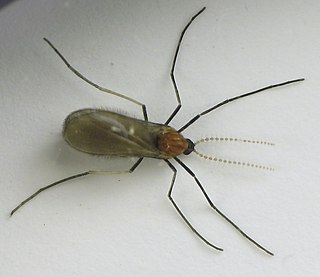
Cecidomyiidae is a family of flies known as gall midges or gall gnats. As the name implies, the larvae of most gall midges feed within plant tissue, creating abnormal plant growths called galls. Cecidomyiidae are very fragile small insects usually only 2–3 mm (0.079–0.118 in) in length; many are less than 1 mm (0.039 in) long. They are characterised by hairy wings, unusual in the order Diptera, and have long antennae. Some Cecidomyiids are also known for the strange phenomenon of paedogenesis in which the larval stage reproduces without maturing first. In some species, the daughter larvae consume the mother, while in others, reproduction occurs later on in the egg or pupa.

Sciaroidea is a superfamily in the infraorder Bibionomorpha. There are about 16 families and more than 15,000 described species in Sciaroidea. Most of its constituent families are various gnats.
Catotricha americana is a species of basal gall midges in the family Cecidomyiidae. It is the type species of the genus and has only been confirmed to occur in New Hampshire. This species was first described by American entomologist Ephraim Porter Felt in 1908.
Catotricha is a genus of midges in the family Cecidomyiidae. The five described species in Catotricha are found in the holarctic region. This genus was established by British entomologist Frederick Wallace Edwards in 1938.
Catotrichinae is a subfamily of Cecidomyiidae. Members of this subfamily were formerly included in Lestremiinae and are considered the most primitive members Cecidomyiidae. The larvae feed on fungi. Five genera are currently recognized.

Rhopalomyia solidaginis, the goldenrod bunch gall, is a species of gall midges, insects in the family Cecidomyiidae The galls of this species have the following host species of goldenrods:Solidago altissima, Solidago canadensis, Solidago rugosa They have been found across eastern North American.
Monardia is a genus of wood midges, insects in the family Cecidomyiidae. The 53 described species in Monardia are grouped into three subgenera.
Micromyinae is a subfamily of wood midges, insects in the family Cecidomyiidae. Its members were formerly included in subfamily Lestremiinae. There are at least 55 genera and more than 650 described species in Micromyinae. All species in this subfamily are mycophageous.
Amedia is a genus of wood midges in the family Cecidomyiidae. The only described species - Amedia floridana - is only known from Florida. The genus was established by Mathias Jaschhof in 1997.
Trichoceromyia is a genus of midges in the family Cecidomyiidae. There is one described species in this genus: Trichoceromyia oregonensis. It is only known from Oregon.
Trichotoca is a genus of midges in the family Cecidomyiidae. There are two described species in this genus, both known only from Australia.
Mesotrichoca is a genus of midges in the family Cecidomyiidae. The one described species in the genus - Mesotrichoca mesozoica - is known only from Siberia from a sediment fossil associated with the Late Jurassic and Lower Cretaceous epochs. This species was placed in Catotricha when it was first described by Russian entomologist Vladimir Grigoryevich Kovalev. This genus was established by Mathias Jaschhof and Catrin Jaschhof in 2008.
Anocha is a genus of midges in the family Cecidomyiidae. The eight described species are known from the holarctic region. The genus was first described by Arthur Earl Pritchard in 1948.
Anodontoceras is a genus of wood midges in the family Cecidomyiidae. There are three described species. The genus was established by Japanese entomologist Junichi Yukawa in 1967.
Ansifera is a genus of midges in the family Cecidomyiidae. The five described species are found in the Palearctic and Oriental regions. The genus was first described by Mathias Jaschhof in 2009.
Antennardia is a genus of midges in the family Cecidomyiidae. The four described species are found in the Holarctic realm. The genus was first described by Boris Mamaev in 1993, but was subsequently treated as a subgenus of Monardia until being reinstated at the genus level.
Gagnea is a genus of wood midges, insects in the family Cecidomyiidae. The one described species - Gagnea tsutaensis - is known only from Japan. The genus was established by Mathias Jaschhof in 2001 and named after American entomologist Raymond Gagné.
Neurolyga is a genus of wood midges, insects in the family Cecidomyiidae. The 28 described species occur in the holarctic region. The genus was established by Italian entomologist Camillo Rondani in 1840.
Polyardis is a genus of midges in the family Cecidomyiidae. The ten described species are found in the Holarctic and Australasian realms. The genus was first described by entomologist Arthur Earl Pritchard in 1947.
Pteridomyia is a genus of midges in the family Cecidomyiidae. The four described species are all found in Australasia. The genus was first described by Mathias Jaschhof in 2003.


